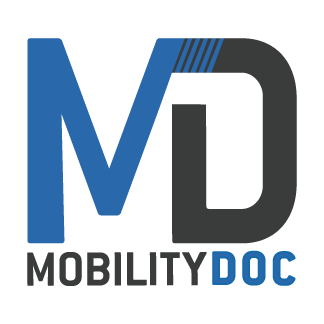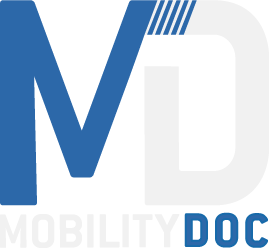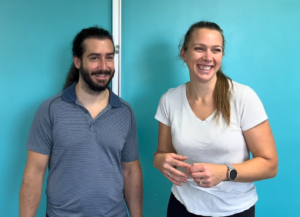A few weeks ago we talked about how our Mobility-Doc Jo(h)n’s are training for their own 400m dash! Of course when it comes to athletics there’s always something to go wrong… In this instance we have a pulled hamstring. Generally hamstrings have a bad wrap as far as healing goes, but what we have found more than anything is they just aren’t treated well! So what is a hamstring strain exactly and how do you get one? We are going to share common ways to pull a muscle, symptoms you may feel, and 3 techniques to help heal your hamstring strain!
What Is A Muscle Strain?
A muscle strain is when the connective tissue and muscle fibers get pushed to the point of tearing. This generally happens when you’re asking your muscle to be longer than it is (yes muscles can be short) or you have a sudden very hard contraction. You can also suffer from a strain when there are large imbalances between front, back or side to side. An example would be an overdeveloped quadricep muscle with weak or underactive hamstrings. These weakened hamstrings are susceptible to strains and tears.
Muscle strains happen in varying degrees. You can go from mild where you’d really only tear a few fibers to severe which is potentially tearing your muscle all the way through! Symptoms of a muscle pull can be tenderness, swelling, bruising, a “popping” sound or sensation, as well as looking like there is a gap or dent where the muscle has torn apart.
How To Heal A Hamstring Strain Fast?
We don’t have any magic wands, but these 3 techniques will definitely help you heal. Oftentimes, many people are told there isn’t anything you can do, just rest, but that just isn’t true. We are going to use 3 different soft tissue mobilization techniques to help break down the adhesions and scar tissue!



 Kind of like a massage, the ball uses pressure to get into the muscle. This helps your nervous system send a signal to your brain that this area of your body needs a little extra loving. In our video example below, we used a field hockey ball, but a lacrosse ball works well too! You want to stay away from tennis balls (too soft) and golf balls (too small) because they’re not quite right for the job.
Kind of like a massage, the ball uses pressure to get into the muscle. This helps your nervous system send a signal to your brain that this area of your body needs a little extra loving. In our video example below, we used a field hockey ball, but a lacrosse ball works well too! You want to stay away from tennis balls (too soft) and golf balls (too small) because they’re not quite right for the job.
 Instrument assisted soft tissue therapy, as Dr. Chloe likes to call it, uses a tool to help increase blood flow and break up knots and adhesions in the area. This is a really effective and tactile way to feel the connective tissues that need work!
Instrument assisted soft tissue therapy, as Dr. Chloe likes to call it, uses a tool to help increase blood flow and break up knots and adhesions in the area. This is a really effective and tactile way to feel the connective tissues that need work!
 Muscle flossing gives you the ability to tack down a specific area while going through a range of motion. This particular technique is also cool because you’re able to flush out the muscle with clean blood when the flossing band releases. Go through a range of motion for 60-90 seconds before taking off the band.
Muscle flossing gives you the ability to tack down a specific area while going through a range of motion. This particular technique is also cool because you’re able to flush out the muscle with clean blood when the flossing band releases. Go through a range of motion for 60-90 seconds before taking off the band.
*Make sure to watch the video!! There is an AMAZING muscle flossing progression!*
Important Tips To Remember
No matter what technique you’re using, there are 2 points that you need to remember. First, it’s really important to go over your entire muscle! If you focus too quickly or too much on just where you think it hurts, you’re not allowing the benefits of these techniques to go to the entire muscle. Not only that, you may actually have more sensitive spots you didn’t realize! You’ll never know if you don’t try to access the whole muscle.
Second, all of these techniques should be done DYNAMICALLY. That means no holding in one position for a long period of time. We are trying to get your muscles to relax and contract properly. Holding any of these techniques for too long isn’t going to do you any favors.
Watch our How To Video:
Active Lifestyles Require Active Recovery
It’s important to remember that active lifestyles come with risks. You may be doing all the right things and still suffer an injury. That doesn’t mean you can’t recover. It especially doesn’t mean you can’t recover quickly! Keep your head up and stay diligent with active recovery methods to heal your hamstring strain. You’ll be back out there in no time!
Do You Know Why Your Hamstring Pulled?
Many lower body issues we have stems from hip dysfunction. Are your glutes are lazy? Maybe your hips forgot they’re supposed to move independently of our back! These are common problems we see every day in our office. Keep your hips doing what they should be by with our our MDRx Hips program. Take 4 weeks to eliminate friction and even out asymmetries that may be causing your pain. It’s never a bad time to improve how you move (especially when it only takes 10-15 minutes a day!). Start now!






